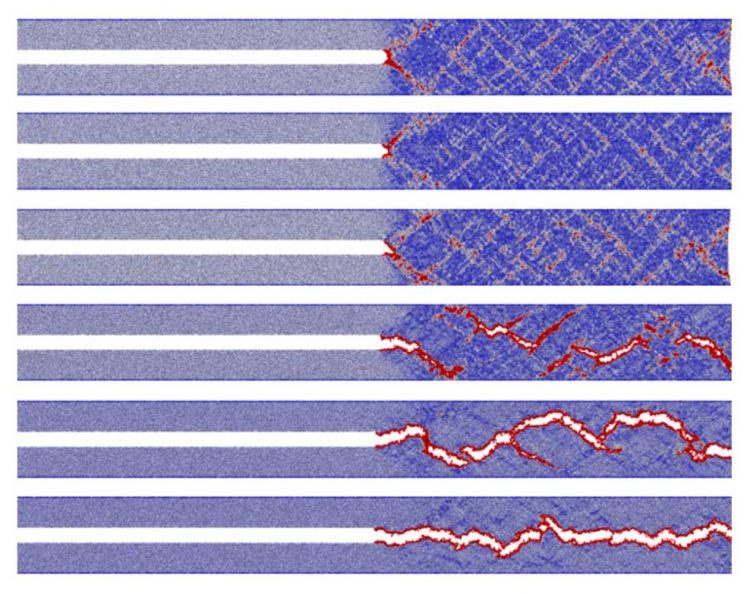Computer model predicts how fracturing metallic glass releases energy at the atomic level

Measuring fracture energy in model glasses with various ductility; showing the deformation morphologies for glasses with various ductilities; and measured fracture energy (and normalized fracture energy by the surface energy). Credit: Binghui Deng and Yunfeng Shi
Metallic glasses — alloys lacking the crystalline structure normally found in metals — are an exciting research target for tantalizing applications, including artificial joints and other medical implant devices. However, the difficulties associated with predicting how much energy these materials release when they fracture is slowing down development of metallic glass-based products.
Recently, a pair of researchers from Rensselaer Polytechnic Institute in Troy, New York, developed a new way of simulating to the atomic level how metallic glasses behave as they fracture. This new modeling technique could improve computer-aided materials design and help researchers determine the properties of metallic glasses. The duo reports their findings in the Journal of Applied Physics, from AIP Publishing.
“Until now, however, there has been no viable way of measuring a quality known as 'fracture energy,' one of the most important fracture properties of materials, in atomic-level simulations,” said Yunfeng Shi, an author on the paper.
Fracture energy is a fundamental property of any material. It describes the total energy released — per unit area — of newly created fracture surfaces in a solid. “Knowing this value is important for understanding how a material will behave in extreme conditions and can better predict how any material will fail,” said Binghui Deng, another author on the paper.
In principle, any alloy can be made into a metallic glass by controlling manufacturing conditions like the rate of cooling. To select the appropriate material for a particular application, researchers need to know how each alloy will perform under stress.
To understand how different alloys behave under different conditions, the researchers utilized a computational tool called molecular dynamics. This computer modeling method accounts for the force, position and velocity of every atom in a virtual system.
In addition, the calculations for the model are constantly updated with information about how the fractures spread throughout a sample. This type of heuristic computer learning can best approximate real-world conditions by accounting for random changes like fractures in a material.
Their model accounts for the complex interplay between the loss of stored elastic energy from an erupting fracture, and how much the newly created surface area of the crack compensates for that energy loss.
“Computer-aided materials design has played a significant role in manufacturing and it is destined to play far greater roles in the future,” Shi said.
###
The article, “On measuring the fracture energy of model metallic glasses,” is authored by Binghui Deng and Yunfeng Shi. The article appeared in the Journal of Applied Physics July 17, 2018, (DOI: 10.1063/1.5037352) and can be accessed at http://aip.
ABOUT THE JOURNAL
Journal of Applied Physics is an influential international journal publishing significant new experimental and theoretical results of applied physics research. See http://jap.
Media Contact
More Information:
http://dx.doi.org/10.1063/1.5037352All latest news from the category: Physics and Astronomy
This area deals with the fundamental laws and building blocks of nature and how they interact, the properties and the behavior of matter, and research into space and time and their structures.
innovations-report provides in-depth reports and articles on subjects such as astrophysics, laser technologies, nuclear, quantum, particle and solid-state physics, nanotechnologies, planetary research and findings (Mars, Venus) and developments related to the Hubble Telescope.
Newest articles

A universal framework for spatial biology
SpatialData is a freely accessible tool to unify and integrate data from different omics technologies accounting for spatial information, which can provide holistic insights into health and disease. Biological processes…

How complex biological processes arise
A $20 million grant from the U.S. National Science Foundation (NSF) will support the establishment and operation of the National Synthesis Center for Emergence in the Molecular and Cellular Sciences (NCEMS) at…

Airborne single-photon lidar system achieves high-resolution 3D imaging
Compact, low-power system opens doors for photon-efficient drone and satellite-based environmental monitoring and mapping. Researchers have developed a compact and lightweight single-photon airborne lidar system that can acquire high-resolution 3D…





















